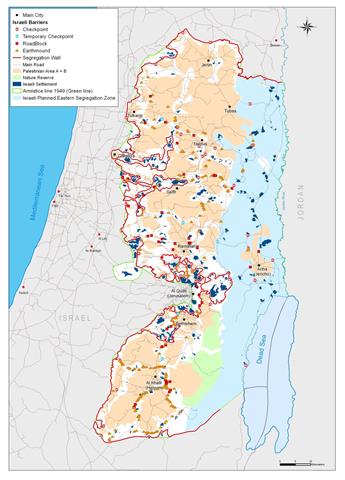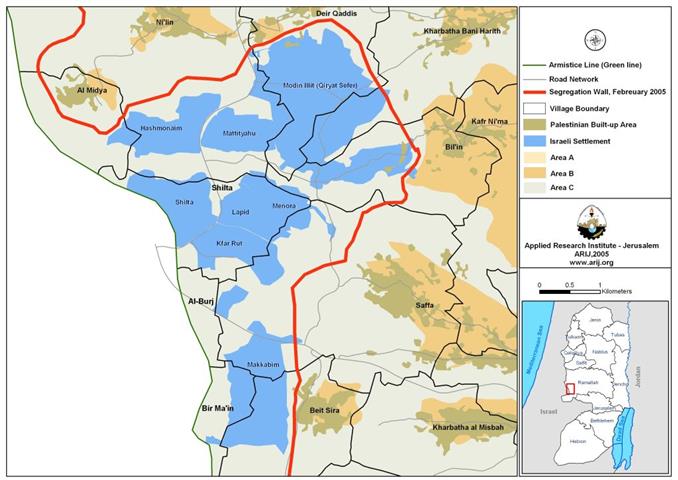Background:
The eastern part of the West Bank includes the Jordan Valley and the upper part of the Dead Sea western shores and occupies an area of 1664 Km2. The 42 Jordan Valley Localities host a total population of 52132 persons (The Palestinian Central Bureau of Statistics â??PCBS- 2005).The Jordan Valley as a geographical region, is formed around the Jordan River and is a part of the â??Great Rift Valleyâ??. Part of it lies in the West Bank and is enclosed between the mountains of the West Bank to the west and the Jordan River to the east.
The successive Israeli Plans which targeted The Jordan Valley
-
Following the 1967 war, Yigal Alon, the defense minister and head of the Israeli Ministerial Committee on settlements at that time, presented a plan to colonize the newly occupied Palestinian territory. In the first stage, the plan demanded securing the region to the west of the Jordan River and west of the Dead Sea shores and constructing a strip of Jewish settlements to act as a buffer between Jordan and the Occupied Palestinian Territory (OPT). This in turn, would surround and control the OPT from all sides and turn the Jordan River into the political and security boundary for Israel.
-
In July 2004, the Israeli Agriculture Minister formulated a new colonial plan which targeted 31,000 Dunums (to be confiscated from Palestinians) in order to expand Israeli settlement areas and to increase settler's population. The plan involved increasing the incentives set for the agriculture sector in Israeli settlements in the Jordan valley area, in addition to increase the number of housing units there.
-
In June 2005, the Israeli Prime Minister at that time Ariel Sharon and the financial committee preliminary approved the plan to invest more than 50 million USD over the coming five years to the 'intensification process' of the Israeli settlements in the Jordan Valley.
In the same month, the Israeli Agriculture Minister, adopted a plan to double the number of the Israeli settlers in the Jordan Valley area over the next three years by increasing the agriculture subsides as well as the development of additional tourism facilities in the area.
-
The Israeli segregation plan in the occupied Palestinian territory maintains a western segregation zone marked by the segregation Wall, an eastern segregation zone that is maintained by imposing a complete closure over the eastern zone area as well as several corridors that further fragment the OPT and maintains an Israeli continuity between the two main zones. The eastern segregation zone grabs 1664 Km2 (29% of the West Bankâ??s area).
The Palestinian communities in the zone are spread over areas classified as A (69 Km2) & B (2 Km2) (according to Oslo II agreement of 1995). It should also be noted that 920 Km2 of the eastern segregation zone is already classified as closed military area since the 1967 Israeli occupation of the West Bank; It is worth mentioning that there are 42 Israeli settlements in the Jordan Valley area that have 11, ooo Israeli settlers; these settlements cover an area of 38 square km (2% of the eastern Segregation Zone). In addition, there are 703 Km2 of the eastern segregation zone which has been illegally classified as State Land over the years of occupation (following the 1967 war).
The Israeli army is imposing a closure over the entire zone area where entrance to and exit from the eastern zone area is totally controlled by military checkpoints that are spread over 200 Km stretch from north to south. Moreover, the residents of the zone are daily targeted by the IOF by house demolitions, lands confiscations, deprivation of basic medical services or proper educational facilities, hygienic drinking water among other aggression activities.
25 Israeli checkpoints (6 of them are permanent checkpoints and the others are flying), block the access of the Palestinian residents into and out of the eastern zone area.The major and difficult checkpoints are:
1. Tayaseer checkpoint (5 kilometers to the southeast of Tubas city).
2. Al Hamra checkpoint (in the northern part of the Jordan Valley).
3. Ma`ale Efrayme checkpoint (in the central part of the Jordan Valley).
4. DCO checkpoint (located to the south of Jericho city).
5. Al Auja checkpoint (located to the north of Jericho city).
6. Beit Ha`arava checkpoint (located to the southeast of Jericho city). See Map
At these checkpoints, Israeli soldiers do not allow Palestinians to cross unless they are residents of the valley's villages. This means those workers, traders, researchers and the average Palestinian travelers who are simply trying to go into or out of the area are denied their right to do so.
The Israeli Violations against the residents of the Jordan Valley since 2005
The Israeli violations in the Jordan Valley were traced and recorded the past year and a half. To take a look over the Israeli violations and aggressions against the Jordan Valley residents, lands and properties since the year 2005 until now, click to download table 1' The Israeli mobility restrictions against the residents of the Jordan Valley Localities (From January 2005- May 2006)'
Movement restrictions in the International and Humanitarian Law:
The Israeli Settlement activities in the West Bank and Gaza Strip clearly violate the International Law rules, International Humanitarian Law, International Legitimacy and also the United Nation Security Council and General Assembly Resolutions. The most relevant resolution which Israel is still violating and neglecting is:
-
UN Security Council Resolution 242 (1967): which calls for 'the withdrawal of all Israeli armed forces from territories occupied' in the 1967 war. UNSC 242 effectively outlaws Israel's 39 year occupation of the West Bank (including East Jerusalem) and the Gaza Strip.
The Israeli checkpoints are prohibited by the International Law as they are major elements that obstruct the mobility of Palestinians in the West bank.
Their presence also violates principles of the Forth Geneva Convention of 1949 such as the following principles:
-
The right of healthcare (Article 56 of the Convention).
-
The right of education (Article 50 of the Convention).
-
The right to freedom of religion (Article 58 of the Convention).
Also Article 3 of the Convention strictly prohibits the occupying power from initiating 'violence to life and person' and 'outrages upon personal dignity, in particular humiliating and degrading treatment'.
Freedom of Movement is guaranteed by Article 12 of the International Covenant on Civil and Political Rights (ICCPR) which states: ''Everyone lawfully within the territory of a State shall, within that territory, have the right to liberty of movement and freedom to choose his residence.
Finally, in spite of all the Israeli aggressions, attacks and colonial plans that aim at making the lives of the 42 Palestinian communities unbearable and seek to displace the Palestinian local residents of the Jordan Valley, the residents of these communities are holding to their lands and properties challenging the occupier by their strong stand and refusal of the Israeli plans.
References:
-
PCBS, Palestinian central Bureau of Statistics. 25 May 2006. Palestinian central Bureau of Statistics. <http://www.pcbs.gov.ps/>.
-
The Palestinian Negotiation Department. Retrieved May 30, 2006. Palestinian Monitoring Group. Website: http://www.nad-plo.org/..
Related Cases:
-
The Plot of the Eastern Segregation Wall!
-
The Israeli colonization activities in the Eastern Segregation Zone!
-
The ongoing Israeli Violations in The Jordan Valley!
Prepared by
The Applied Research Institute – Jerusalem
ARIJ













